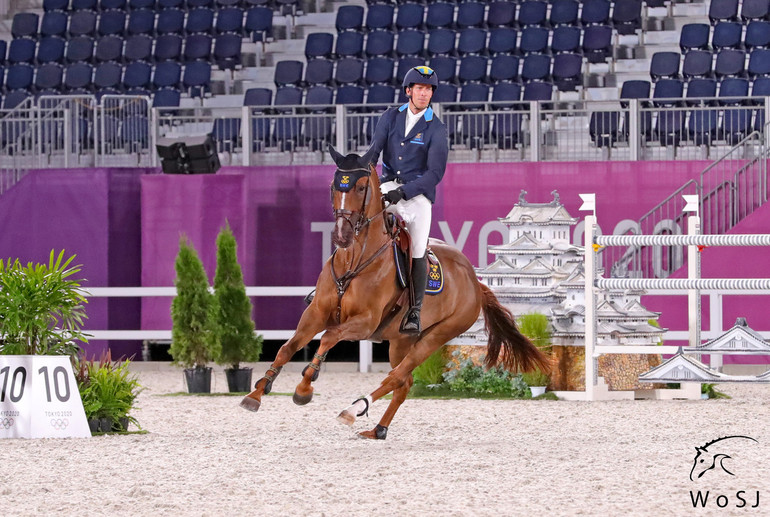Text © World of Showjumping
Since the beginning of 2022, a change in the FEI Jumping Rules has come to affect the number of penalties riders can obtain during their rounds. Exceeding the time allowed is now penalized with one penalty for each second commenced, whereas before, one penalty was added for every four seconds. Currently ranked number two on the Longines Ranking, Sweden’s Olympic team gold medallist Henrik von Eckermann believes the rule change has made the sport more interesting. “I am completely in favour of the rule,” the Swede tells World of Showjumping.
“Especially in the biggest classes, there is no question about it; that’s where the rule makes the most sense – at championships and in Grand Prix classes on the highest level,” von Eckermann points out. “However, I also believe it works on the other levels of the sport.”
The time allowed is one of the factors that determine the difficulty of each class; the higher the level, the harder it will be to stay within the time allowed
“If you take the Tokyo Olympics and the difference between Sweden and France as an example, there was only two penalties separating us. Yet, with those two penalties you could have been eight seconds over the time allowed,” von Eckermann continues. “The time allowed is one of the factors that determine the difficulty of each class; the higher the level, the harder it will be to stay within the time allowed. In a five-star, if you are one or two seconds over the time allowed, that can happen – but if you are more than four seconds over the time allowed, then you are simply not doing what is asked. One of the demands at five-star level is being able to ride at a high pace, and the time allowed is such an important tool for the course designers. If the time allowed is just a tiny bit too long, you have a whole other number of clear rounds. There is a huge difference in being able to take a little check and put your horse back on its hind legs somewhere in the course versus not being able to add strides anywhere due to a tight time allowed. Also, you might have to make a short turn in order to save time – but this is high level sport, it should be demanding. If someone is trying and has a rail down, while someone doesn’t even try and goes five seconds over the time, the latter should be penalized more. Under the new regulations, time faults are easy to get if you don’t watch out, and in my opinion it makes the sport interesting.”
“On the lower levels, with young horses and smaller classes, the time allowed should of course reflect those circumstances. Course designers have regulations to follow – they can’t do whatever they want – but they can measure longer turns. You should not have to chase around your young horse,” von Eckermann says. “In the past, riding a training round with a young horse, going from corner to corner, might have been penalized with three time faults, because you could easily be 12 seconds over the time allowed. Now, instead of three penalties, the same approach will be penalized with 12 penalty points in the results, which of course looks different. This might worry those who live from horse dealing; when you have big numbers on results lists it might not look too appealing to potential clients.”
If someone rides from corner to corner, that is not competing, and horse shows are called competitions for a reason
“The time allowed should absolutely be measured so that you don’t have to rush a young horse,” von Eckermann continues. “However, if someone rides from corner to corner, that is not competing, and horse shows are called competitions for a reason. If someone is not ready to risk getting a high number of penalties for riding too slow, then they should be jumping at training shows – which are for training purposes. You have to be ready to ride in a pace that gets you within the time allowed; this is simply one of the requirements at any show, at any level.”
“Maybe the solution is to find a way of displaying the results in a way that separates time faults from other penalties,” von Eckermann concludes. “However, I don’t personally think that it is a big problem. Getting one penalty for one second is also easy for the wider audience to understand. Find a solution in displaying the penalty scores is something we should consider, but the rule itself has to stay, it would be absolutely wrong to go back to how it was.”
*Editor’s note:
At the beginning of 2022, the FEI Jumping Rules article 236.1 (vii) was changed. Under the rule change, exceeding the time allowed in all competitions run as a Table A is penalized with one penalty for each second commenced instead of the previous one penalty point for each four seconds commenced.
According to the article 227 in the FEI Jumping Rules, “(…) the time allowed for a round in each competition is determined in relation to the length of the course and the speeds set forth under JRs Art. 234 and Annex II.” Longines Ranking competitions counting for Longines Ranking point groups AA through D at CSIs and CSIO come with a minimum and maximum speed requirement: 375 m/minute minimum and 400 m/minute maximum outdoors and 350 m/minute minimum indoors. For young horse competitions, a speed of 325 m/minute is a minimum.
No reproduction without written permission, copyright © World of Showjumping.com









